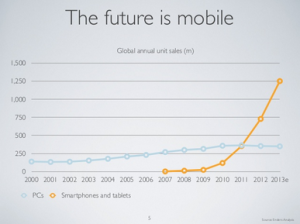Media
Native Content: The Cure For
Mobile Advertising’s Woes
The rise of mobile is undeniable: mobile devices now account for over half of adults’ time spent online, according to a new report from Comscore and Jumptap, and many in the younger demo are going mobile-only. That leaves brands and publishers alike with a big problem: display ads don’t work on mobile. They’re so ineffective that they only fetch a minuscule $0.75 CPM, compared to $3.50 for desktop, according to renowned Wall Street analyst Mary Meeker’s 2013 internet trend’s review. Brands don’t want to pay for them, and publishers can’t use them to monetize their mobile traffic. So what’s the industry to do?
The solution — right now, the only solution — is native advertisements. Feed-based design dominates the mobile web, and in such an environment, “interruptive” ads, such as banners, distract users at best and upset them at worst. Advertisements that integrate seamlessly into the feed, however, are very effective in such an intimate environment. And as Digiday reports, publishers and social networks are increasingly embracing this reality and doubling down on native ads.
But what exactly is a “native ad”? The term seems to spur a lot of confusion. Simply put, a native ad mimics the user interface and experience that contains it. So Google AdWords, Facebook sponsored stories, Buzzfeed sponsored posts, and the CitiBike locator section of the New York Times’ “The Scoop” app are all examples of native ads, since they integrate with the user interface and experience.
FACEBOOK SPONSORED STORIES:
BUZZFEED’S SPONSORED POSTS:
On Mobile, Content is King, Queen and Court
With mobile CPMs so low, publishers are prioritizing sponsored posts or sponsored in-app experiences more and more as a monetization strategy. You can see this in how everyone from Mashable to The Economist now has a branded content department.
That makes sense given what we know about mobile display ads; they’re the lowest quality ads on the market, non-targeted and indifferent to user experience. “Getting 75 cents on banners for cell phones is a miracle,” Andy Wiedlen, CRO at Buzzfeed, said at a recent Advertising Week panel. “It’s economics: unlimited supply and not much demand.”
For brands, that puts a premium on on having a brand-publishing infrastructure in place, so that they can seed high-quality content in as many places as possible.
After all, while banner ads perform dismally on mobile, content performs quite well. In a 2012 study, Readability found that users spent significantly more time per article on mobile than desktop. And like publishers, social networks — from Twitter, to Tumblr, to LinkedIn, Facebook and Instagram — are becoming hyper-focused on helping brands engage users through content. It’s no coincidence that 71% of people use mobile to access social media, according to an Adobe study in July.
For brands, there’s no alternative at the moment. Mobile display ads pose such a serious false-click problem that Google was forced to institute a double click rule because attribution had gone haywire. Zombie traffic — or bot traffic — is also starting to rise on mobile and will likely continue to render CPMs for banners flawed. Even the so-called “rising star” mobile ad units, premium interruptive ads, only offer a minuscule boost in brand recall and other awareness factors.
It appears as though targeted display ads will offer a dramatic improvement over the current crop of display ads, but they are still a ways off. As AdAge reported this summer, the startup ecosystem around targeted is still coming together, and as The New York Times reported, the technology is still in its infancy.
And when targeting on mobile does improve, the opportunities to serve those experiences to the right people will only grow, causing mobile spend to finally catch up with mobile usage.”
That leaves one solution: Content ads and search ads native to the mobile experience. Thanks to the power of intent, search ads will always be effective — but only for particular kinds of brand initiatives. And they’re becoming prohibitively expensive, with some keywords fetching over $40 per click.
Ultimately, that puts even more of a premium on brands becoming publishers and creating content.
While that may scare some marketers, it’s actually an extremely pleasant outlook for advertising as a whole. It’s a world where advertising is centered on the opportunity to create experiences that people like and want to share. And when targeting on mobile does improve, the opportunities to serve those experiences to the right people will only grow, causing mobile spend to finally catch up with mobile usage.
The mobile revolution is just beginning; for brands, step one is getting their content streamlined and ready for lift off.
Want your business to tell great stories like this one? Contently gives brands the tools and talent to tell stories that people love. Learn more.
Image by DTKUTOO/ShutterstockGet better at your job right now.
Read our monthly newsletter to master content marketing. It’s made for marketers, creators, and everyone in between.





